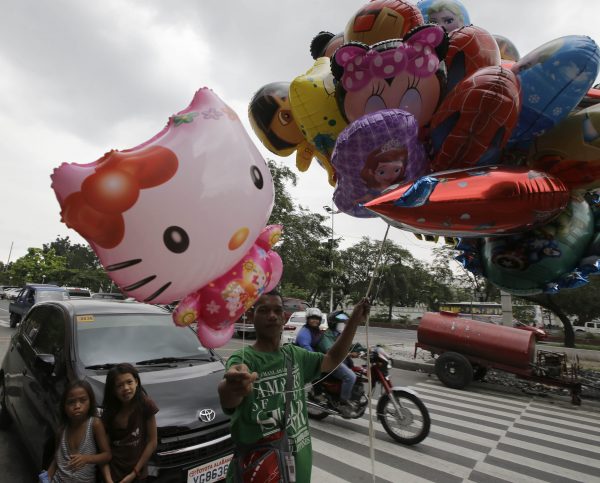Since she was created by Sanrio Inc. in 1974, Hello Kitty’s image has donned numerous items, from pencils to lunchboxes to high-end jewellery, electric guitars and motor scooters. Hello Kitty was introduced to the US market in 1976, followed by European markets in 1980 and official Asian markets in 1990. Now Hello Kitty’s expanded global ‘girl’ culture has made her one of the most widely recognised symbols of kawaii around the world.
Proof of her broad appeal abroad was displayed at the Japanese American National Museum in Los Angeles in 2014–2015 with the exhibit that I curated, ‘Hello! Exploring the Super Cute World of Hello Kitty’. This exhibit broke all attendance records at the museum with fans flocking from across the United States.
The exhibit coincided with another first for Sanrio: ‘Kitty Con’, a four-day convention of Hello Kitty fans held at The Geffen Contemporary at the Museum of Contemporary Art marking the 40th anniversary of Sanrio’s icon. Sold out two weeks in advance, Kitty Con drew a frenzied crowd of over 2600 fans, many of who travelled thousands of miles to attend.
The juxtaposition of these two events, framed within established cultural institutions, underlines the place of Hello Kitty in global culture, at least from an American perspective.
The Japanese government has followed Hello Kitty and other global pop Japanese figures in close pursuit, incorporating them into the fold of its ‘Cool Japan’ project of the 2000s, which paints Japan as a hip, youth-oriented, trendsetting figure. Hello Kitty was named Japan’s Ambassador of Tourism to Taiwan and Korea in 2008.
But what are we to make of such large-scale promotional campaigns, captured within representations of smallness? How do we interpret the tiny mouthless figure of Hello Kitty, navigating waters laden with colonial histories and political debate?
These questions afford us the possibility of exploring what I call ‘kawaii diplomacy’ — that is, strategic negotiations based upon ‘cute’ positioning. In such diplomacy, Hello Kitty represents a highly successful soft-power niche for Japan. This niche builds upon an arsenal of performed innocence that justifies retreat from responsibility.
Innocence forms a large part of the appeal of Hello Kitty in her smallness, muteness and blankness—and her very gendered position as an ageless female third-grader. These qualities are evident in the character’s spare design and nostalgic tie to childhood. Innocence itself, as a foundational aspect of kawaii, creates relational ambiguities, treading muddy waters of control and manipulation.
If one places innocence within a parent–child paradigm, those relational ambiguities problematise the loci and forms of power. Does the parent hold the power of stewardship? Does the child hold the power of manipulation? How do both forms of power negotiate within a framework of dependency?
But even more significant than the ambiguity surrounding power is the position of victimhood that the notion of innocence raises. Kawaii diplomacy ultimately teases us with the idea of Japan as victim, rather than as perpetrator. Here discussion of soft power may be critical. What areas of international relations do soft power — in the hands of kawaii diplomacy — obscure? The positioning of Hello Kitty as one face of Japan represents the power of the would-be child, at once appealing, seemingly benign, and ever in need of care and nurturance. Kawaii diplomacy builds upon affect and nostalgia, rather than on critical thinking. And in doing so throws a soft pink blanket upon the razor-sharp edges of history.
One of the ironies of kawaii diplomacy is the contrasting attitude toward Japanese youth culture, domestically and internationally. Youth in Japan who opt out of the system in terms of employment (for example ‘furitaa’ who do not have or seek fulltime employment), school (dropouts), or public life (hikikomori or ‘shut-ins’) incite strong criticisms and even moral panic. At the same time, pop culture products associated with and consumed by Japanese youth, including its social misfits, are marketed as sources of national pride and influence — in other words, soft power.
Hello Kitty’s kawaii diplomacy is highly gendered, juxtaposing the feminised ‘small’ figure of Hello Kitty within large, masculinist frames of nation branding. The degree to which we can agree with national image being sold through this small figure remains questionable. Ultimately, kawaii diplomacy must be called into question, not only for its efficacy, but also for its deeply wrought implications.
Christine Yano is Professor of Anthropology at the University of Hawai`i at Manoa


This is an interesting concept Christine. However, I’m just not too convinced. Maybe this is a solid hypothesis for the future, as global youth grow up in a world where they increasingly devour pop culture and may come to associate Kawaii culture permeated by Japan as characteristic of Japan. However, I’m not sure that has happened at all just quite yet. But I do think it would be interesting to hear more about how kawaii culture may be used to construct passive traits within Japanese society.
Now how do you suppose that a plastic toy has anything whatsoever to do with power?
This is a forum for serious debate, or so I had thought.
Japan uses Hello Kitty this kawaii diplomacy, to some extent, quiet useful. Nowadays, a lot of chinese teenagers are crazy about Japanese anime, even most of them like cosplay.